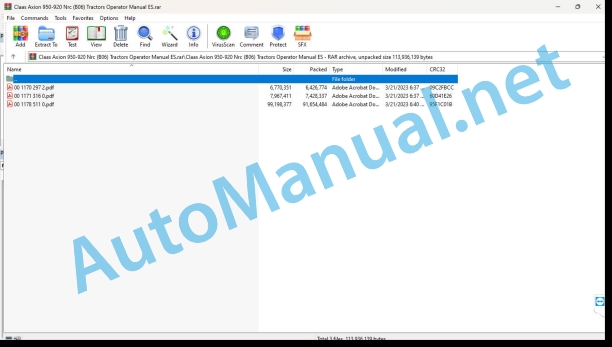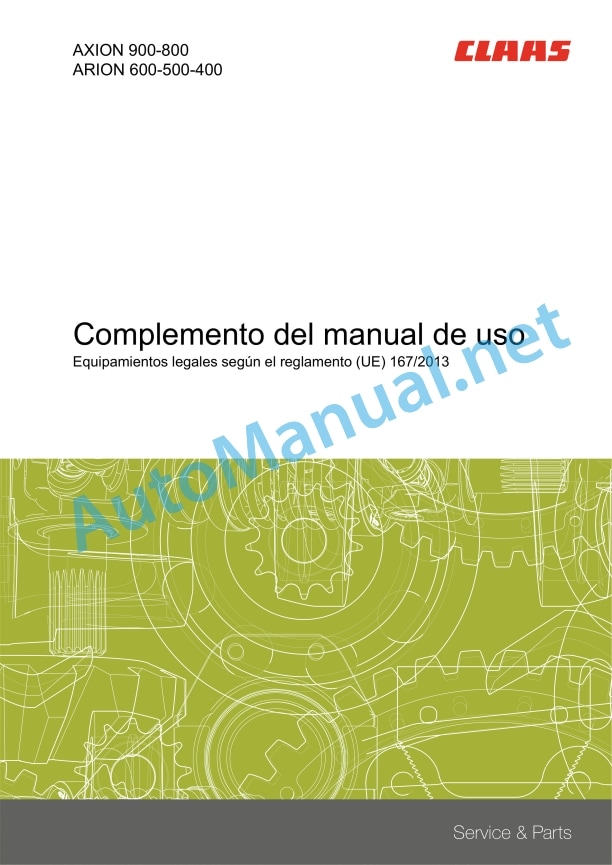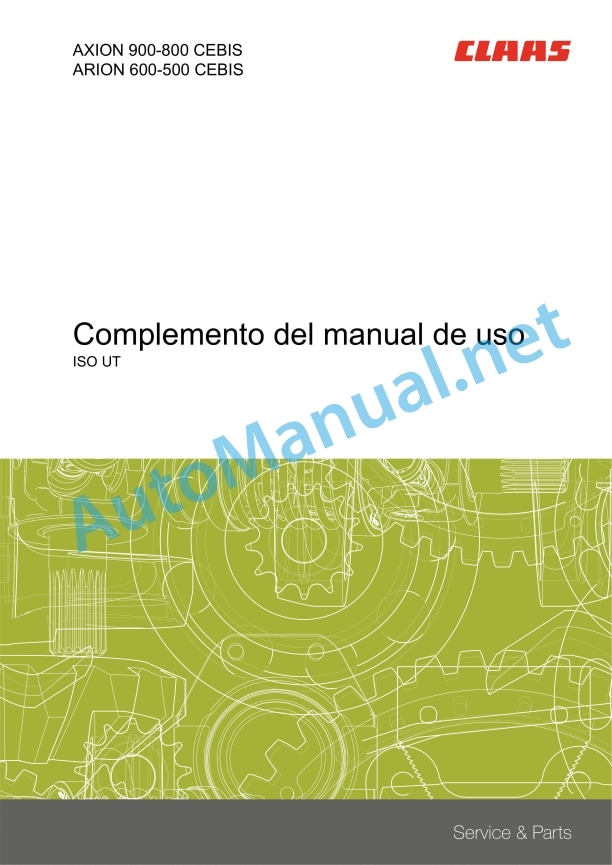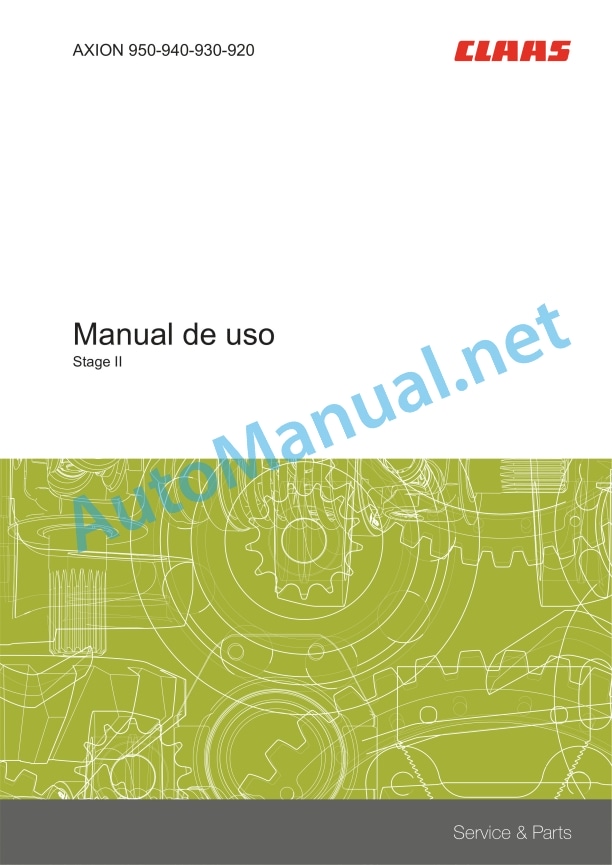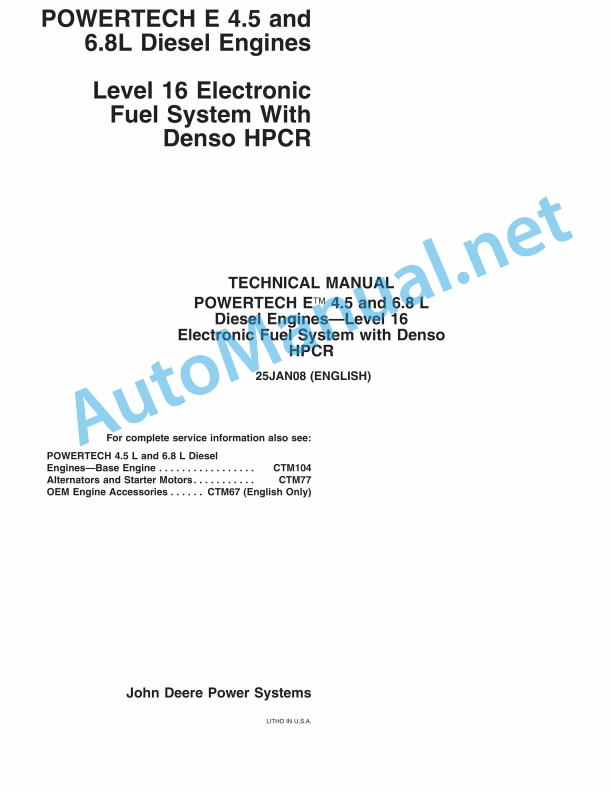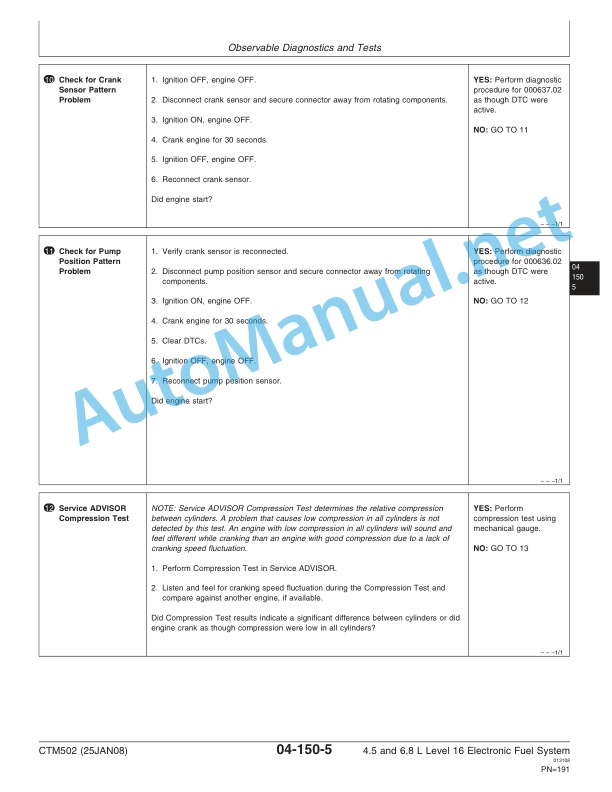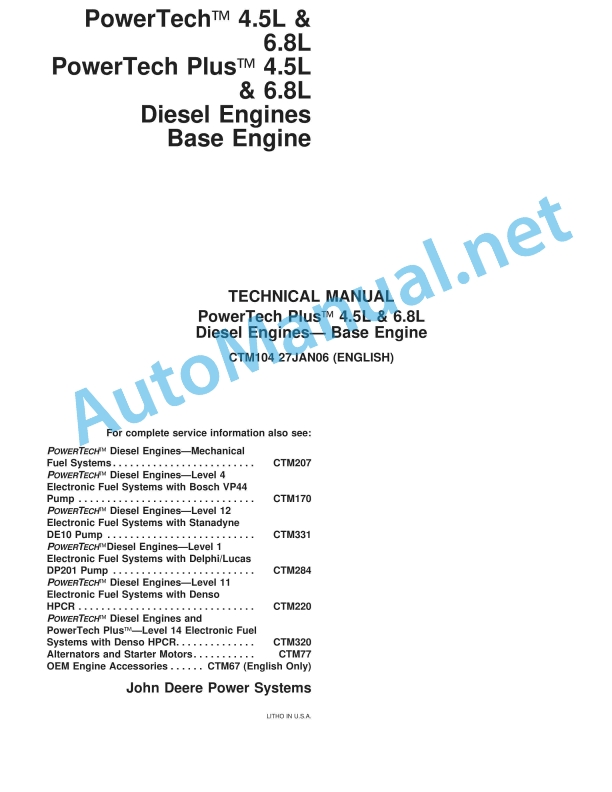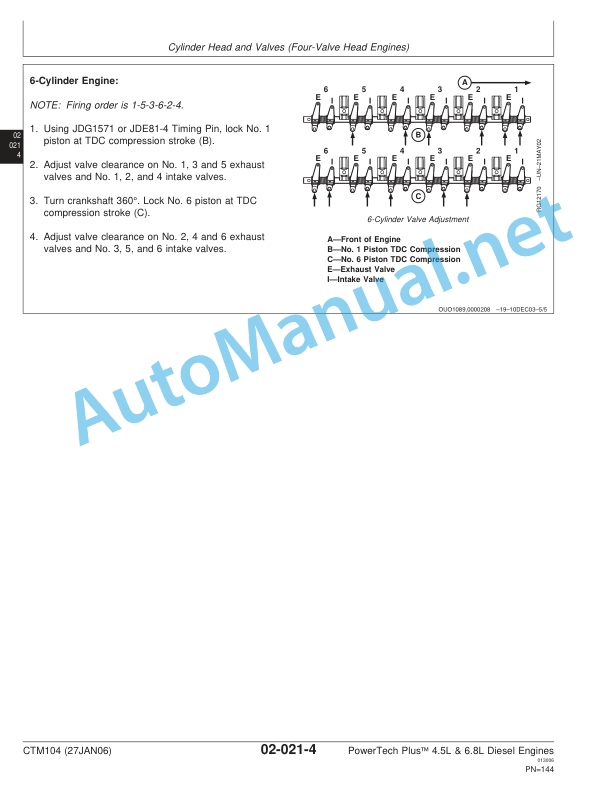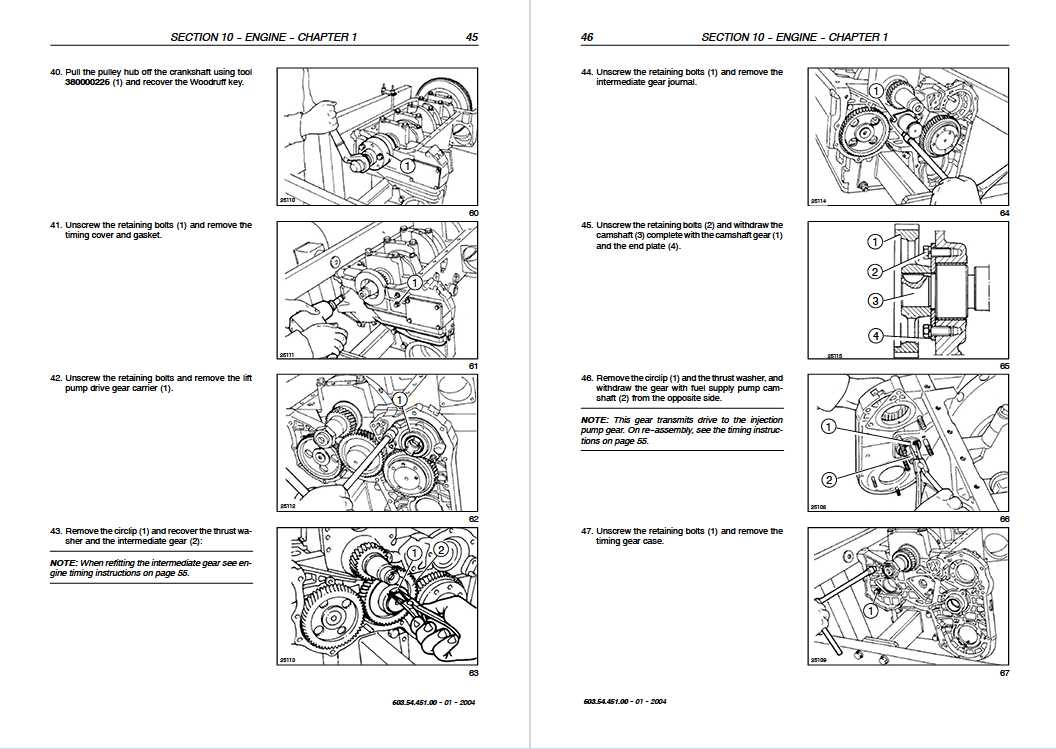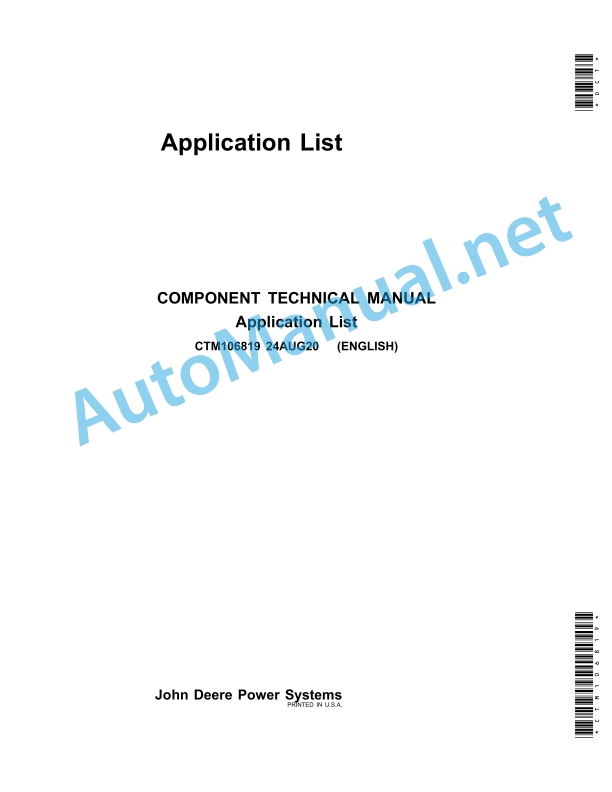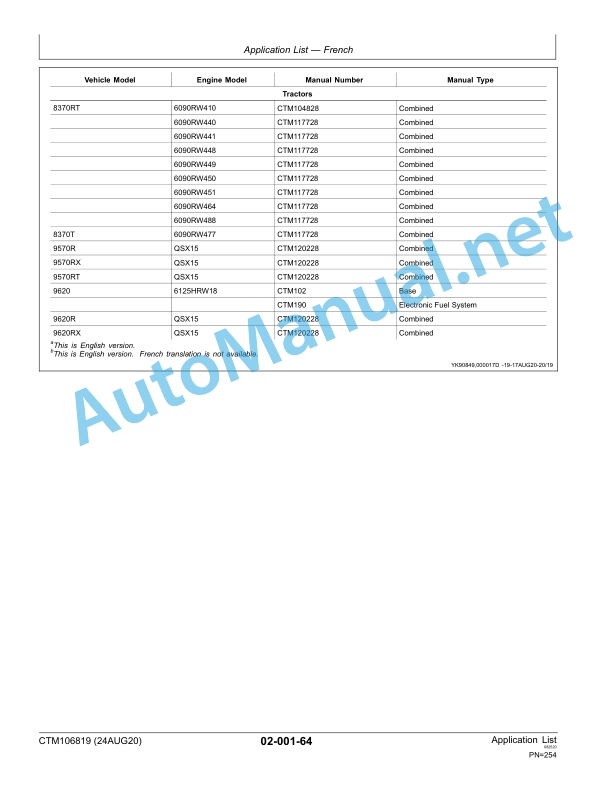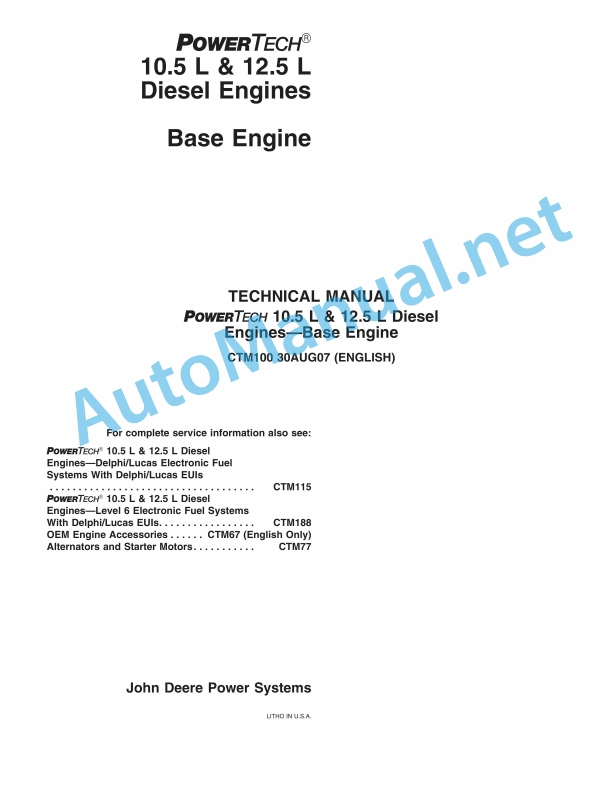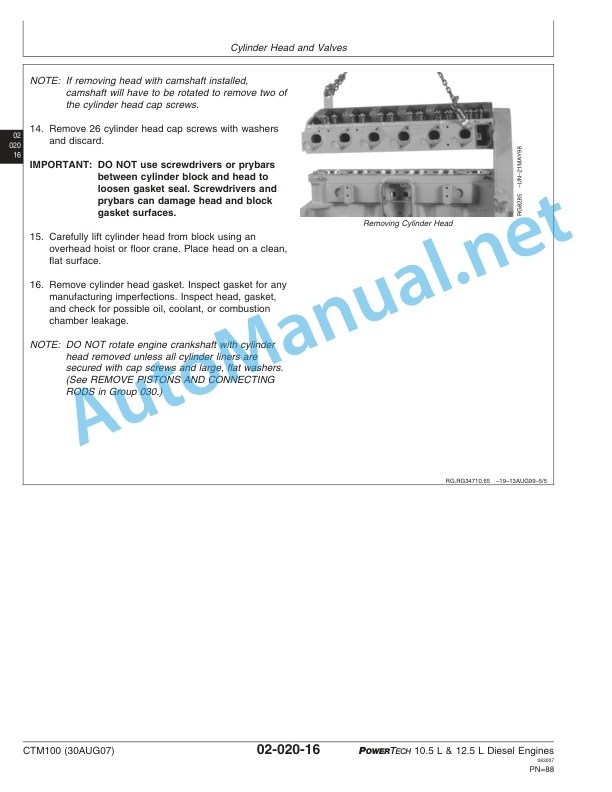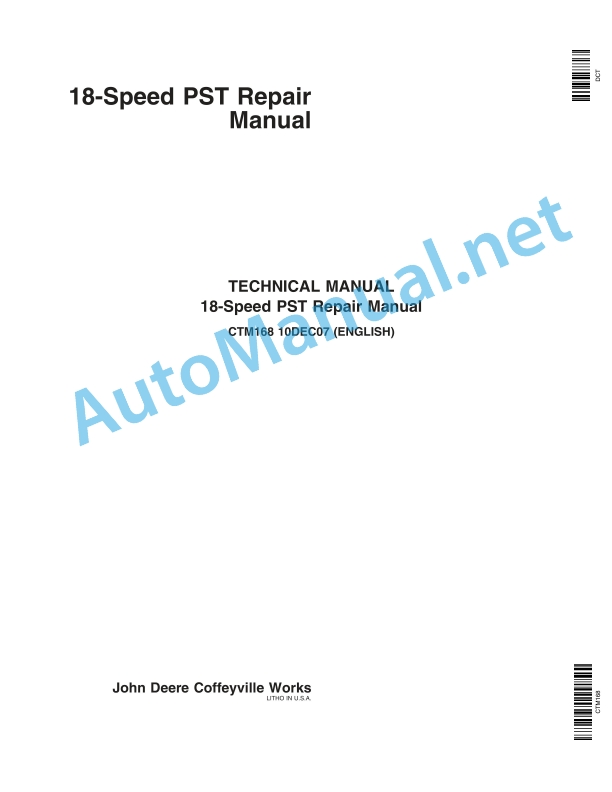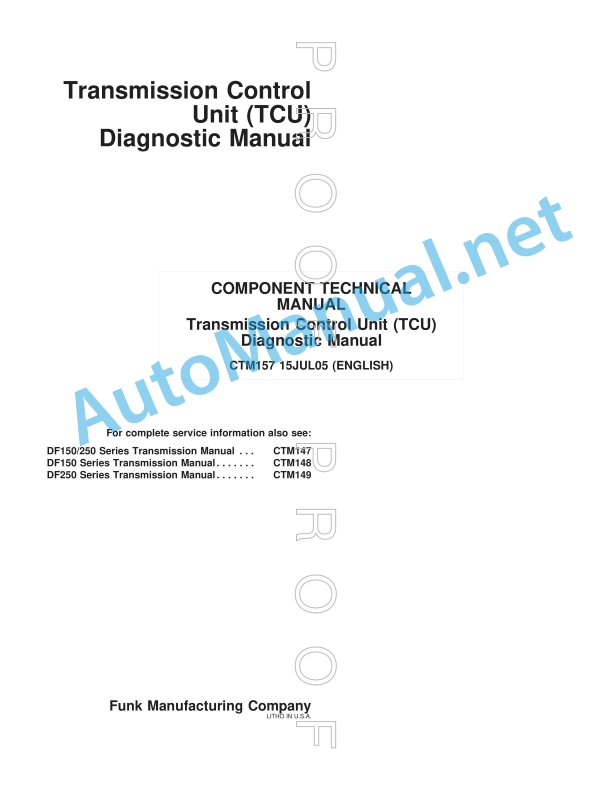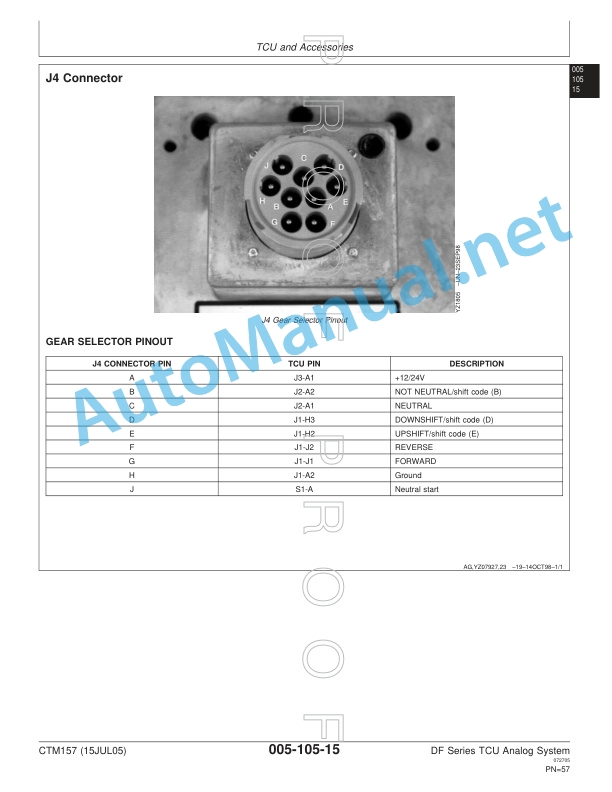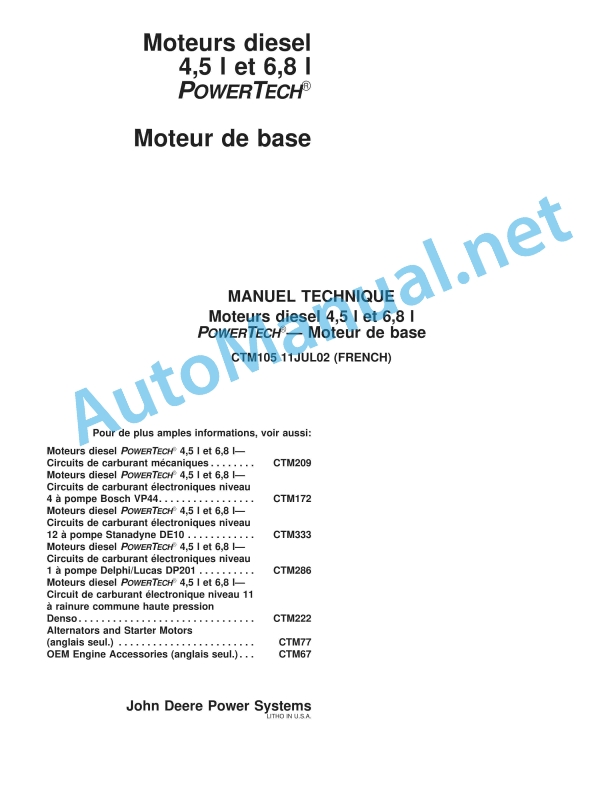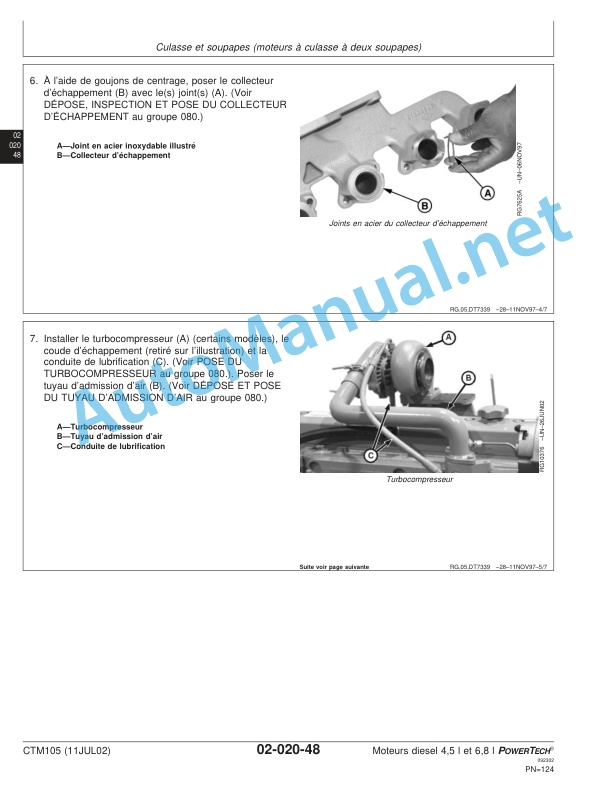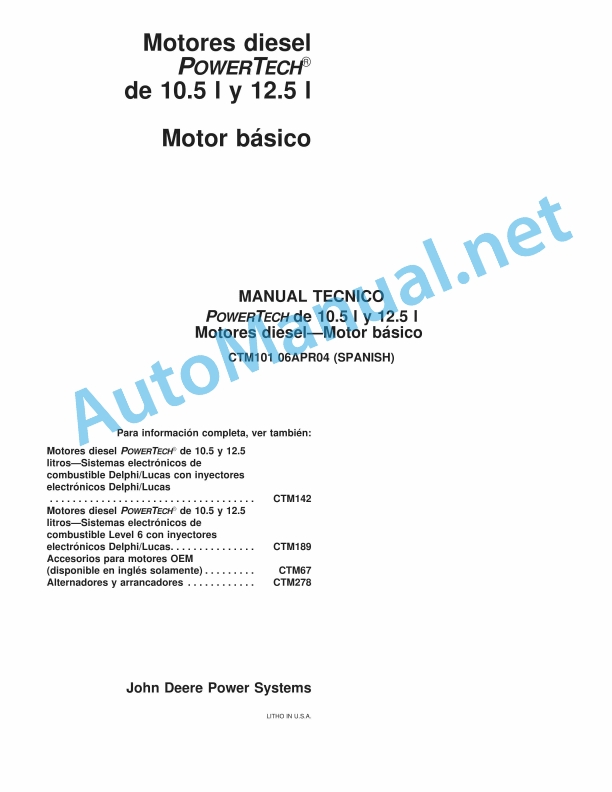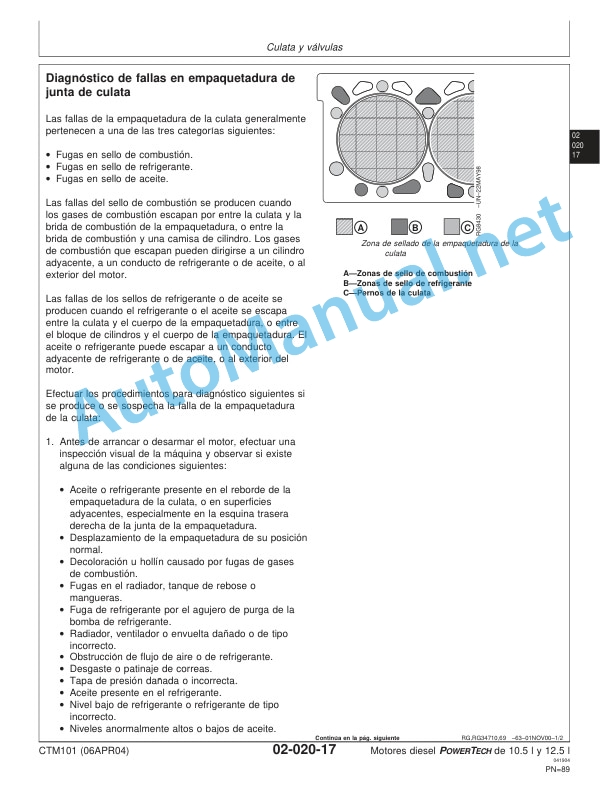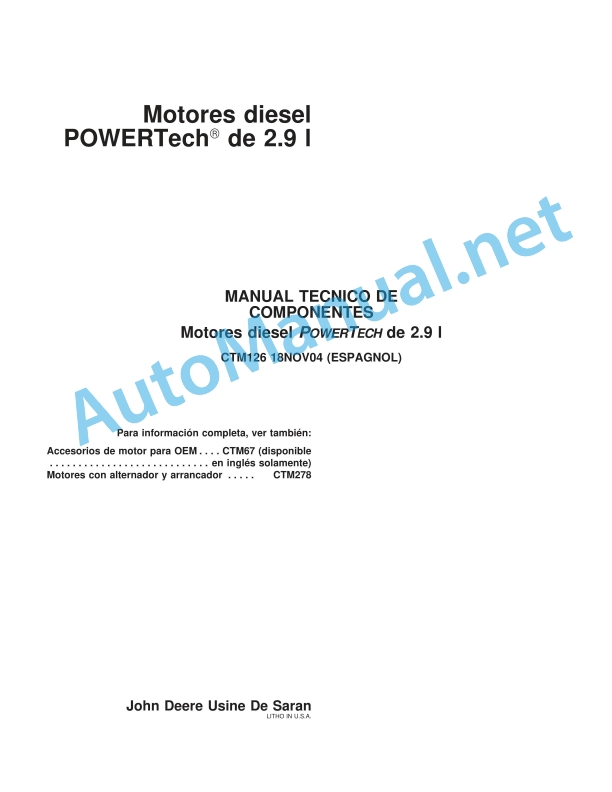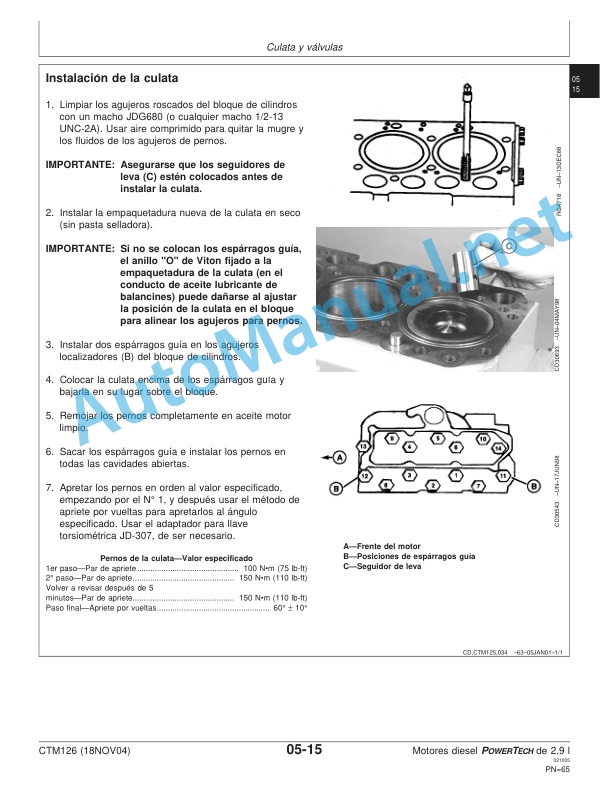Claas Axion 950-920 Nrc (B06) Tractors Operator Manual ES
$50.00
- Model: Axion 950-920 Nrc (B06) Tractors
- Type Of Manual: Operator Manual
- Language: ES
- Format: PDF(s)
- Size: 101 MB
File List:
00 1170 297 2.pdf
00 1171 316 0.pdf
00 1178 511 0.pdf
00 1170 297 2.pdf:
AXION 900-800ARION 600-500-400
1. Introduction
1.1 Information regarding the instruction manual
1.1.1 Application of this manual
2 Prepare the tractor
2.1 Assembly and body parts
2.1.1 Legal equipment according to regulation (EU) 167/2013
Tractor with a length greater than 4.6 m: AXION 900, AXION 800, ARION 600 and ARION 500
Tractor with a total width greater than 2.55 m: AXION 900, AXION 800, ARION 600 and ARION 500
CIS tractor with a total width greater than 2.82 m and CEBIS tractor with a total width greater than 2.75 m: AXION 900, AXION 800, ARION 600 and 500
Tractor with a total width greater than 2.55 m: ARION 400
Tractor with a total width less than 2.55 m: ARION 600, 500 and 400
CIS tractor with an overall width of less than 2.82 m: AXION 900, AXION 800, ARION 600 and 500
CEBIS tractor with a total width of less than 2.75 m: AXION 900, AXION 800, ARION 600 and 500
Extension of signage posters
00 1171 316 0.pdf:
AXION 900-800 CEBISARION 600-500 CEBIS
1. Introduction
1.1 Information regarding the instruction manual
1.1.1 Application of this manual
2 Control and display instruments
2.1 CEBIS
2.1.1 Work phases
road mode
Field mode
ISO Terminal Mode
2.1.2 Work phases
ISO Terminal Mode
2.1.3
2.1.4 Menu
00 1178 511 0.pdf:
User manual
1. Introduction
1.1 Information regarding the instruction manual
1.1.1 Validity of the user manual
1.1.2 Use the user manual
Important information about this user manual
Structuring according to tractor subassemblies
Search and find
Direction signs
Specific terminology
Optional equipment and supplementary equipment
1.1.3 Symbols and instructions
Texts and illustrations
Indication of dangers and warnings
1.1.4 Optional equipment
1.1.5 Software Updates
1.1.6 Qualified specialized workshop
1.1.7 Maintenance instructions
1.1.8 Information regarding warranty
1.1.9 Spare parts and technical questions
1.1.10 Transfer of the tractor to a third party
2 Security
2.1 Safety instructions
2.1.1 Use according to assignment
2.1.2 Use not in accordance with assignment
2.1.3 Safety and accident prevention instructions
2.1.4 Tractor driving
2.1.5 Checking the condition of the tractor
2.1.6 Get into the cabin and get off the tractor.
Climb aboard the tractor
Get off the tractor
2.1.7 Passenger seat
2.1.8 Cabin
Cabin safety structure
Polluted environment
Cab category
Category 2 (dust protection)
Category 3 (protection against dust and aerosols)
2.1.9 Necessary precautions before start-up
2.1.10 Tool attachment
2.1.11 Adjustment and maintenance work
Particularities of placing the tractor on lifting supports
2.1.12 Use of the front and rear power take-offs
2.1.13 Fuel
2.1.14 Engine coolant
2.1.15 Air conditioning
2.1.16 Electrical system
2.1.17 Applications with front loaders
2.1.18 Forestry applications
2.1.19 Work in fixed position
2.1.20 Implements that work at great depth
2.2 Safety marking on the tractor
2.2.1 General advice regarding safety markings
2.2.2 Warning symbols
2.3 Safety devices
2.3.1 Moonbreaker hammer
2.3.2 Wheel chocks
2.3.3 Fire extinguisher support
2.3.4 First aid kit
2.3.5 Signal triangle
3 Description of the tractor
3.1 Overview
3.1.1 Left front view
3.1.2 Left rear view
3.2 Identification plates and vehicle identification number
3.2.1 Tractor nameplate
French nameplate (type 1)
French nameplate (type 2)
International nameplate
Eurasia zone nameplate (type 1)
Eurasia zone nameplate (type 2)
Tractor identification number
Regulatory tractor type
Tractor serial number
3.2.2 Motor nameplate
3.2.3 Gearbox nameplate
3.2.4 Rear axle nameplate
3.2.5 Front axle nameplate
3.2.6 Front power take-off nameplate
3.2.7 Cab nameplate
Situation 1
Situation 2
3.2.8 Supplementary cabin nameplate
French supplementary nameplate for cabin 1
French cabin 2 complementary nameplate
French cabin 3 complementary nameplate
French cabin 4 complementary nameplate
International supplementary cabin nameplate
Additional identification plate for the Euroasia zone cabin
3.3 Information on the tractor
3.3.1 Wheel tightening
3.3.2 Tractor power label
3.3.3 Lifting points
3.3.4 Slinging points
3.3.5 Emergency exit
Cab tailgate
00 2606 644 0
Right cabin door
00 2606 644 0
Right side moon
00 2616 658 0
3.3.6 Speed and direction of rotation of the front power take-off
3.3.7 Electrical and electronic system
3.3.8 Automatic electrical circuit breaker
3.3.9 Engine hood
3.3.10 Tractor loading procedure reminder
3.3.11 Control of convoy immobilization
3.3.12 Grease points
Pull hook
00 2607 920 0
Front linkage and front axle
00 2648 932 0
rear lift
00 2610 355 0
4 Control and display instruments
4.1 Cabin and driving position
4.1.1 Multifunction armrest
4.1.2 CMOTION multifunction lever
4.1.3 CEBIS Terminal
road screen
Work screen
4.1.4 Cabin top
4.1.5 Right cab pillar
4.1.6 Dashboard
4.1.7 Instrument panel
4.1.8 Main screen
4.1.9 Manual air conditioning control
4.1.10 Automatic air conditioning
4.1.11 Control panel for work lights and rotating flashing light
4.1.12 Driving position control levers
Signal lights and acoustic warning
Wiield wipers and washers
.1.13 Electrical sockets on the right terminal
4.2 Hydraulic installation
4.2.1 Hydraulic controls
4.3 Electrical and electronic system
4.3.1 External controls
Rear exterior controls
Front exterior controls
4.4 CEBIS
4.4.1 Introduction to CEBIS
Description
Functioning
4.4.2 CEBIS menu structure
4.4.3
4.4.4 Front linkage/Rear linkage
4.4.5 AUTOPILOT
4.4.6 Hydraulic
4.4.7 On-board computer
4.4.8 CLAAS Sequence Management (CSM)
4.4.9 Previewing a sequence in real time
5 Technical data
5.1 AXION 950 – 920
5.1.1 Tractor dimensions
5.1.2 Tractor weight
Measurement conditions
5.1.3 Engine
5.1.4 Gearbox
5.1.5 Front axle
Suspended front axles equipped with brakes
Suspended front axles
Reinforced rigid front axles
Rigid front axles
5.1.6 Rear axle
5.1.7 Front track table
Fixed disc rim
Variable disc rims
5.1.8 Rear track table
Fixed disc rim. flange shafts
Fixed Disc Rim – Short Plain Axles
Fixed Disc Rim – Long Plain Axles
5.1.9 Rear track table with twin wheel spacers
Fixed disc rim, track with 2.5 meter smooth axles
Fixed disc rim, track with 3 meter smooth axles
5.1.10 Tire combinations
5.1.11 Tire inflation pressures and load capacity
Rear tires
Front tires
5.1.12 Brakes
5.1.13 Tractor steering
5.1.14 Rear linkage
5.1.15 Front linkage
5.1.16 Rear hitches
5.1.17 Rear PTO
5.1.18 Front power take-off
5.1.19 Main hydraulic circuit (LS 150 l/min)
5.1.20 Main hydraulic circuit (LS 220 l/min)
5.1.21 Electrohydraulic distributors
5.1.22 Electrical circuit
5.1.23 Cabin characteristics
Noise level in the driver’s ears (according to European directive 2009/76)
Noise level in the ears of a passerby (according to European directive 2009/63 Annex VI)
5.1.24 Seat vibration level
5.1.25 Ballast
5.1.26 Maximum allowable towable masses
5.1.27 Tractor load capacities
5.2 Inputs
5.2.1 Lubricants and hydraulic oils
5.2.2 Engine coolant
5.2.3 Air conditioning cooling agent
6 Prepare the tractor
6.1 Engine
6.1.1 Fuel
Fuel quality requirement
Particularities of biofuels
Fuel handling
6.1.2 Filling the tractor tank
6.1.3 Cold Engine Start/Engine Coolant Heater
6.2 Framework
6.2.1 Put the rear axle on the track
Flanged wheel axles
smooth wheel axles
smooth wheel axles
6.2.2 Front axle track adjustment
6.2.3 Adjust the rotation stops
Jack Placement
Placing the lifting supports
Adjust the front axle rotation stops
6.2.4 General characteristics of the tires
6.2.5 Tire inflation pressure
Effect on soil compaction
Effect on consumption
Twin Wheel Assembly Case
6.2.6 Features
Load index
speed index
6.2.7 Mounting twin wheels on smooth axles
smooth shafts
smooth shafts
6.2.8 Placement of spacers for mounting twin wheels
6.2.9 Use of wheel chocks
6.3 Brake
6.3.1 Engage the brake pedals
6.3.2 Trailer pneumatic brake
6.3.3 Hydraulic trailer brake
6.4 Address
6.4.1 Steering column
6.5 Rear linkage
6.5.1 Hitching and unhitching an implement
Hitch Recommendations
Disengagement
6.5.2 Lifting supports
6.5.3 Mechanical upper connecting rod
6.5.4 Hydraulic upper link
6.5.5 Stabilizers
Mechanical stabilizers
Self-Locking Stabilizers
6.5.6 Automatic hooks
6.5.7 External controls
6.6 Front linkage
6.6.1 Hitching/unhitching an implement
Hitch Recommendations
Disengagement
6.6.2 Mechanical upper connecting rod
6.6.3 Lower cranks
6.6.4 Automatic hooks
6.6.5 Front lift mechanism external controls
6.7 Rear PTO
6.7.1 Hitching and unhitching an implement
Connecting and disconnecting the rear power take-off cardan
Disengagement
6.7.2 PTO socket
6.8 Front power take-off
6.8.1 Hitching and unhitching an implement
Disengagement
6.9 Towing device
6.9.1 Recommendations
6.9.2 Calculate the maximum towable load
6.9.3 Hitching/unhitching an implement
Disengagement
6.9.4 Hitch pin
6.9.5 Oscillating bar
Lateral positions
Longitudinal displacement
Maximum Hitch Sweep Angles
Safety device
Swing Bar Jaw Tightening
Hitching an implement
6.9.6 Hitch forks
Fork with bolt
automatic fork
ball fork
CUNA forks
Spindle wear
6.9.7 Bar with ball
Forced direction
6.10 Rear hydraulic system
6.10.1 Rear pressure taps
Connection of pressure taps
Disconnection of pressure taps
6.10.2 Connecting an implement to the Power Beyond
6.11 Front hydraulic system
6.11.1 Connect a hydraulic tool to the front hydraulic pressure ports
6.12 Electrical and electronic system
6.12.1 Adjust the low beam headlights
Adjusting the dipped headlights on the engine hood
Cab low beam adjustment
6.12.2 External electrical outlets
Rear external electrical sockets
Front external electrical sockets
6.12.3 Connect a camera to the CEBIS terminal
6.13 Cabin and driving position
6.13.1 Cab suspension adjustment
6.13.2 Adjust the exterior mirrors
Adjusting the separation of the exterior mirrors
Adjusting the orientation of the exterior mirrors (manual adjustment)
Mirror orientation adjustment (electronic adjustment)
Defrosting the exterior mirrors
6.13.3 Adjusting the Grammer air suspension seat
6.13.4 Adjustment of the heated seat with semi-active air suspension
6.13.5 Seat adjustment with active air suspension
6.13.6 Passenger seat
6.13.7 Multifunction armrest
6.13.8 Positioning of the CEBIS screen
6.13.9 Roof compartment (depending on equipment)
6.13.10 Mobile storage box (depending on equipment)
6.13.11 Storage compartment
6.13.12 Armrest compartment
6.13.13 Route of the cables of a control console
6.13.14 Installation of a control console in the cabin
6.13.15 Installation of a control console in the cabin
6.13.16 Cab front light brackets
6.14 Assembly and body parts
6.14.1 Retractable step
6.14.2 Ballast
6.14.3 Liquid ballast
6.14.4 Balancing the tractor with mounted implements
Summary table
6.14.5 Mass on the front hydraulic linkage
6.14.6 Assembly and disassembly of the front masses
Base front monobloc mass
Additional front monobloc mass
6.14.7 Ballast mass of 1800 kg
Attach ballast mass of 1800 kg
Add the additional mass of 400 kg
Add a toolbox to the ballast mass
6.14.8 Rear wheel weights
Wheel weights for 38” rims (type 1)
Wheel weights for 38” rims (type 2)
Wheel weights for 38” rims (type 3)
Wheel weights for 42” rims
Wheel weights for 44 or 42” rims
6.15 Transport of the tractor1 Tractor transport
6.15. clearance reflectors
Deploy the external clearance reflectors
Adjust the lateral extension of the external clearance reflectors
Retract the external clearance reflectors
6.15.3 Load the tractor
7 Management
7.1 Engine
7.1.1 Start the engine
7.1.2 Accelerator pedal
7.1.3 Hand throttle
7.1.4 Engine speed memories
Activation of an engine speed memory
Manual adjustment of engine speed memories (method 1)
Manual adjustment of engine speed memories (method 2)
Adjustment of engine speed memories from CEBIS
7.1.5 Turn off the engine
7.2 Transmission, clutch and cardan shaft
7.2.1 Clutch pedal
7.2.2 Put the transmission in neutral position
Transmission reactivation
7.2.3 Driving mode selection
CEBIS Menu
“Mode” switch
7.2.4 Select the direction of travel of the tractor
Tractor travel direction reversal lever
Tractor travel direction reversal switch
5 Configuration of speed ranges
Sng the maximum speed of a speed range
Adjusting the speed setpoint of a speed range
7.2.6 Select a speed range
7.2.7 Automatic mode
Move the tractor forward
tractor stop
Emergency stop
Engine brake
Setting the convoy in motion with the service brakes activated
7.2.8 DRIVESTICK mode
Move the tractor forward
tractor stop
Emergency stop
Engine brake
Setting the convoy in motion with the service brakes activated
7.2.9 Manual mode
Move the tractor forward
tractor stop
Emergency stop
Engine brake
Setting the convoy in motion with the service brakes activated
7.2.10 Activation of the speed setpoint of a speed range
Activation of the speed setpoint of an active speed range
Save and activate instant tractor speed
7.2.11 Tractor acceleration adjustment
7.2.12 Droop Adjustment
Automatic mode and DRIVESTICK mode
Engine RPM Memory Mode
7.2.13 Locking the differentials
Automatic mode
Permanent mode
7.3 Chassis
7.3.1 Front axle suspension
Fixed mode
Automatic mode
7.3.2 Front axle drive
Automatic mode
Permanent mode
7.4 Brake
7.4.1 Service brakes
Tractors equipped with two brake pedals
Tractors equipped with single brake pedal
7.4.2 Parking brake
7.4.3 Parking brake assistance
7.4.4 Checking the immobilization of the convoy by the tractor
7.5 Address
7.5.1 AUTOPILOT
7.6 Rear linkage
7.6.1 Recommendations
7.6.2 Transport security
7.6.3 Unlocking the rear linkage
7.6.4 Rear lifting mechanism raising/lowering controls
Step by step mode
7.6.5 Position control
7.6.6 Effort control
7.6.7 Rear linkage top stop
7.6.8 Descent speed
7.6.9 Transport buffer
7.6.10 Active skating management
7.7 Front linkage
7.7.1 Recommendations
7.7.2 Transport security
7.7.3 Conversion of the front linkage into single-acting or double-acting
7.7.4 Use of the front linkage
Unlocking the front linkage
Front linkage raising/lowering
7.7.5 Front linkage position control
7.7.6 Front hydraulic lift transport shock absorber
7.7.7 Front linkage high stop adjustment
7.7.8 Setting the front hydraulic lift speed
7.7.9 Front hydraulic lift lowering speed adjustment
7.8 Rear PTO
7.8.1 Recommendations
7.8.2 Select a rear power take-off regime
7.8.3 Use the rear power take-off control in the cabin
7.8.4 Use the external controls of the rear power take-off
7.8.5 Automatic deactivation of the rear power take-off
Activation of the automatic deactivation of the rear power take-off
Adjustment of the automatic deactivation of the rear power take-off
Display of the current configuration of the rear power take-off deactivation automation
7.8.6 Work in fixed position
7.9 Front power take-off
7.9.1 Recommendations
7.9.2 Use of the control in the cabin
7.9.3 Work in fixed position
7.10 Rear hydraulic system
7.10.1 Association of controls with rear pressure taps
Distribution block composed of three rear electrohydraulic distributors
Distribution block composed of four rear electrohydraulic distributors
Distribution block composed of six rear electrohydraulic distributors
7.10.2 Activate the electrohydraulic distributors
7.10.3 Using online controls
7.10.4 Using the cross control
7.10.5 Use of external controls
7.10.6 Using the hydraulic control of the multifunction lever
7.10.7 Adjustment of the flow rate of the pressure taps of the auxiliary electrohydraulic distributors
7.10.8 Setting the hydraulic timer of an electrohydraulic distributor
7.10.9 Activation of external controls to control the selected auxiliary electrohydraulic distributor
7.10.10 Locking an auxiliary electrohydraulic distributor
7.10.11 Activation of the hydraulic control of the multifunction lever to control the selected electrohydraulic distributor
7.10.12 Conversion of electrohydraulic distributor 1 into single-acting/double-acting
7.10.13 Work in fixed position
7.10.14 Power Beyond
7.11 Front hydraulic system
7.11.1 Association of the controls with the front pressure intakes
Front pressure intakes fed by the electrohydraulic distributor 2
Front pressure intakes fed by electrohydraulic distributors 7 and 8
7.11.2 Activation of the front electrohydraulic distributors
7.11.3 Using the in-line control of the electrohydraulic distributor 2
7.11.4 Using online controls
7.11.5 Using the cross control
7.11.6 Use of the front external controls (depending on tractor equipment)
7.11.7 Adjustment of the flow rate of the pressure taps of the auxiliary electrohydraulic distributors
7.11.8 Setting the hydraulic timer of an electrohydraulic distributor
7.11.9 Activation of external controls to control the selected auxiliary electrohydraulic distributor
7.11.10 Locking an auxiliary electrohydraulic distributor
7.11.11 Activation of hydraulic control of the multifunction lever to control the selected auxiliary electrohydraulic distributor
7.11.12 Work in fixed position
7.12 Electrical and electronic system
7.12.1 Manual circuit breaker
7.12.2 Electronic circuit breaker
7.12.3 Automatic electronic short circuit
7.12.4 Automatic electronic short circuit
7.12.5 Using a camera with the CEBIS terminal
7.13 CLAAS SEQUENCE MANAGEMENT
7.13.1 CLAAS SEQUENCE MANAGEMENT
7.13.2 Programming a sequence
7.13.3 Start of a sequence
7.13.4 Interrupting a sequence
Momentary interruption of a sequence in progress
Definitive interruption of a momentarily interrupted sequence
Permanent interruption of a sequence in progress
Interruption of ongoing actions
Emergency stop
7.14 Cabin and driving position
7.14.1 Automatic air conditioning
On/off on the instrument panel
Automatic defrosting and defogging of the windows
Ventilation orientation management
Outside temperature
Air recirculation in the cabin
Automatic air conditioning management
air cooling
Ventilated air flow adjustment
Cabin air temperature adjustment
Use in contaminated environments
7.14.2 Manual air conditioning control
Ventilated air flow adjustment
Ventilation orientation management
Ventilated air temperature adjustment
Activation of air recirculation
Activation of air cooling
Use in contaminated environments
7.14.3 Instrument panel screens
Main screen
7.14.4 Ceiling lights
7.14.5 Exterior mirrors
Simple mirror
Double mirror rearview mirror
7.14.6 Side windscreen wipers and washers
8 Incident and solution
8.1 Alarms
8.1.1 Primary alarms
8.1.2 Tractor braking system pressure failure
8.1.3 Engine coolant temperature too high
8.1.4 Battery charging
8.1.5 Incorrect rear axle control pressure
8.1.6 Incorrect engine oil pressure
8.1.7 Low engine oil level
8.1.8 Hydraulic oil temperature too high
8.1.9 Presence of water in the fuel prefilter
8.1.10 Insufficient pressure in the pneumatic circuit
8.1.11 Parking brake applied
8.1.12 Incorrect gearbox control pressure
8.1.13 Incorrect gearbox oil temperature
8.1.14 Incorrect speed information
8.1.15 Secondary alarms
8.1.16 Clogged engine air filter
8.1.17 Clogged hydraulic oil filter
8.1.18 Gearbox oil filter clogging
8.1.19 Engine speed too high
8.1.20 Tractor speed too high
8.1.21 Maintenance intervals
8.1.22 Operating anomalies
Interruption of the acoustic signal accompanying an alarm
8.1.23 Steps to resolve various anomalies
8.1.24 Reminder of maintenance to be carried out
Maintenance counter reset
8.2 Engine
8.2.1 Failure due to lack of fuel
8.2.2 Startup assistance
Tow-assisted start
Starting assisted by external battery
8.3 Transmission, clutch and cardan shaft
8.3.1 Inadequate CMATIC gearbox oil temperature
CMATIC box operation in cold temperatures
High transmission oil temperature
8.3.2 Undetected driver presence
8.4 Framework
8.4.1 Jack placement
8.4.2 Changing a wheel
8.4.3 Tractor towing
Trailer with engine running
Trailer with engine off
8.4.4 Unclogging the tractor
Tractor unclogging
Unclogging a tractor by towing
8.5 Brake
8.5.1 Wear of parking brake discs
8.6 Electrical and electronic system
8.6.1 Primary fuse board
Fuse assignment
Relay assignment
8.6.2 Relay and fuse board
Fuse assignment
Relay assignment
8.6.3 Relay and fuse board (PRF)
Fuse assignment
Relay assignment
8.6.4 Computer board
Assignment of calculator modules
Relay assignment
8.6.5 Calculator plate
Assignment of calculator modules
Relay assignment
8.6.6 Cabin top plate
Fuse assignment
Relay assignment
8.6.7 Cabin top plate
Fuse assignment
Relay assignment
8.6.8 Cabin top plate
Fuse assignment
Relay assignment
8.6.9 Lights overview
8.6.10 Calibration of the tractor instrument panel
8.7 Cabin and driving position
8.7.1 Table of error codes for air conditioning with automatic control
8.7.2 Failure of air cooling in the cabin
8.8 Assembly and body parts
8.8.1 Frontal impact on the monobloc mass located at the front of the tractor
9 Maintenance
9.1 Maintenance instructions
9.1.1 Personal protective equipment
9.1.2 Tractor immobilization and securing
9.1.3 Clean and organize risk areas
9.1.4 Welding instructions
9.1.5 Protection devices on the tractor
9.1.6 Engine
Alternator
Engine lubrication
engine cooling
engine belts
9.1.7 Wheels and tires
9.1.8 Braking system
9.1.9 Pneumatic circuit
9.1.10 Address
9.1.11 Power take-off driven tools
9.1.12 Air conditioning
9.1.13 Hydraulic circuit
9.1.14 Electrical system
9.1.15 Energy accumulators
9.1.16 Spare parts
9.1.17 Greasing
9.1.18 Cleaning/protection
9.1.19 Work at height
9.1.20 Handling of heavy parts
9.1.21 Maintenance operations under the cabin
9.1.22 Lifting the front of the tractor
9.2 Summary of maintenance intervals
9.2.1 Management of maintenance intervals
9.2.2 First 100 hours of service
9.2.3 First 600 hours of service
9.2.4 First 1800 hours of service
9.2.5 Every 10 hours of service
9.2.6 Weekly
9.2.7 Every 50 hours
9.2.8 Every 100 hours of service
9.2.9 Every 300 hours or every six months
9.2.10 Every 600 hours of service
9.2.11 Every 600 hours or annually
9.2.12 Every 1200 hours of service
9.2.13 Every 1800 hours of service
9.2.14 Every 1800 hours of service or every two years
9.2.15 Every 3000 hours
9.2.16 Every 3600 hours
9.2.17 Every 6000 hours
9.3 Greasing scheme
9.3.1 Grease points – 50 h
9.3.2 Grease points – semi-annually
9.4 Engine maintenance operations
9.4.1 Drain the water present in the fuel prefilter
9.4.2 Changing fuel filters
Fuel decanter prefilter
Fuel filter
9.4.3 Bleed the air from the fuel circuit
9.4.4 Check the engine oil level
9.4.5 Change engine oil
9.4.6 Change the engine oil filter
9.4.7 Replacing the centrifugal oil vapor filter
9.4.8 Check the fan
9.4.9 Check the coolant level
9.4.10 Clean the refrigerators
9.4.11 Check the tightness of the cooling circuit
9.4.12 Change the engine air filter
9.4.13 Replacing the motor safety cartridge
9.4.14 Check the tightness of the air intake
9.5 Gear maintenance operations
9.5.1 Replacing the gearbox oil filter
9.6 Chassis maintenance work
9.6.1 Check the front axle differential case oil level
9.6.2 Check the oil level of the front axle final reductions
9.6.3 Change the front axle differential case oil
Suspended front axle
Rigid front axle
9.6.4 Change the oil in the front axle final reductions
9.6.5 Clean the front axle vents
9.6.6 Check the condition of the wheels, tires and tire inflation pressure
9.6.7 Check the tightness of the wheel discs on the hubs
9.6.8 Check the tightness of the wheel discs on the rims
9.6.9 Checking the tightness of the twin wheel mounting spacers
9.7 Brake maintenance operations
9.7.1 Replacing the circuit breaker filter
9.7.2 Checking the parking brake clearance
9.7.3 Check the coupling heads of the pneumatic braking system
9.7.4 Check trailer air braking system bleed valves
9.8 Maintenance work at the address
9.8.1 Replace the auxiliary steering hydraulic pump oil filter
9.8.2 Replacing the steering auxiliary hydraulic pump head
9.9 Front power take-off maintenance operations
9.9.1 Check the oil level of the front power take-off box
9.9.2 Replace the oil and clean the front power take-off housing filter
9.10 Hydraulic installation maintenance work
9.10.1 Check the hydraulic circuit.
9.10.2 Check hydraulic/transmission oil level
9.10.3 Change hydraulic/transmission oil
9.10.4 Replace the hydraulic circuit oil filter
9.10.5 Replacing the hydraulic circuit shower head
9.10.6 Change the rear axle breather
9.10.7 Empty the oil recovery drums
Oil recovery container for rear hydraulic couplers
Front hydraulic coupler oil recovery container
9.11 Electrical/electronic installation maintenance work
9.11.1 Cleaning and greasing the battery terminals
9.11.2 Checking the battery electrolyte solution level
9.12 Cabin/driving position maintenance operations
9.12.1 Cleaning the cabin shock absorbers
9.12.2 Clean the cabin air filter
9.12.3 Replacing the cabin air filter
9.12.4 Clean the cabin air recirculation filter
9.12.5 Replace the cabin air recirculation filter
9.12.6 Start the air conditioning
9.12.7 Check the windshield washer fluid level
9.13 Bodywork maintenance operations
9.13.1 Clean the grill grates
9.13.2 Check the tightness of the engine hood
9.13.3 Check the tightening of the front mass fixing screws
9.13.4 Checking the tightening of the additional masses of the rear wheels
9.14 Parking
9.14.1 Tractor parking
Long term parking
New commissioning
10 Decommissioning and waste disposal
10.1 Information about the machine
10.1.1 Disposal and waste disposal
11 Technical dictionary and abbreviations
11.1 Technical dictionary and abbreviations
11.1.1 Technical terms
11.1.2 Abbreviations
John Deere Repair Technical Manual PDF
John Deere POWERTECH E 4.5 and 6.8 L Diesel Engines TECHNICAL MANUAL 25JAN08
John Deere Repair Technical Manual PDF
John Deere Repair Technical Manual PDF
John Deere Application List Component Technical Manual CTM106819 24AUG20
John Deere Repair Technical Manual PDF
John Deere Repair Technical Manual PDF
John Deere 18-Speed PST Repair Manual Component Technical Manual CTM168 10DEC07
John Deere Repair Technical Manual PDF
John Deere Transmission Control Unit Component Technical Manual CTM157 15JUL05
John Deere Repair Technical Manual PDF
John Deere Repair Technical Manual PDF
John Deere Repair Technical Manual PDF
John Deere Diesel Engines POWERTECH 2.9 L Component Technical Manual CTM126 Spanish

